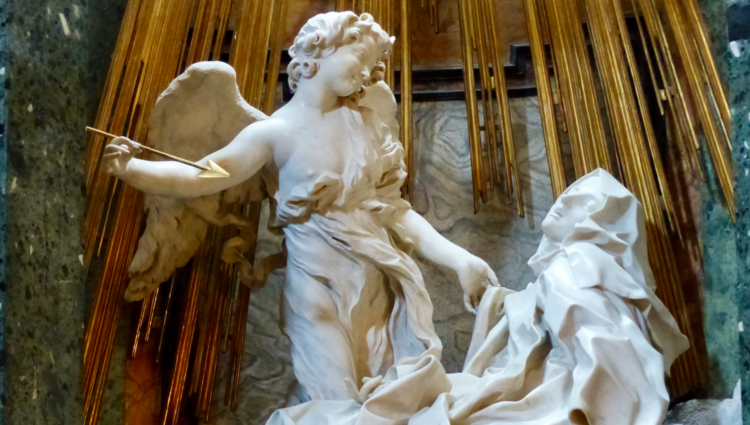Just as the Catholic Faith has been reduced to little more than an intellectual philosophy of life for the clergy—all head and no heart—the same happened to the laity, who depend on them for their spirituality.
 In the immediate aftermath of the Council of Trent, Catholic spirituality, in both theory and practice, reached a height never reached before since the early Church. Founded on the Council of Trent, this new Catholic spirituality was inspired and guided by such great saints as St. Charles Borromeo, St. Robert Bellarmine, St. Francis de Sales, St. Teresa of Avila, and St. John of the Cross. Many new religious orders, and a galaxy of mystics and saints, rose to inspire the Council of Trent and to promote it. In modern times, great Catholic spiritual writers and historians such as Garrigou-Lagrange, O.P., Tanqueray, Pourrat, Poulain, Louis Bouyer, Msgr. Philip Hughes, Louis Cognet, and so many others have seen 17th-century Catholic spirituality as a high point in Catholicism.
In the immediate aftermath of the Council of Trent, Catholic spirituality, in both theory and practice, reached a height never reached before since the early Church. Founded on the Council of Trent, this new Catholic spirituality was inspired and guided by such great saints as St. Charles Borromeo, St. Robert Bellarmine, St. Francis de Sales, St. Teresa of Avila, and St. John of the Cross. Many new religious orders, and a galaxy of mystics and saints, rose to inspire the Council of Trent and to promote it. In modern times, great Catholic spiritual writers and historians such as Garrigou-Lagrange, O.P., Tanqueray, Pourrat, Poulain, Louis Bouyer, Msgr. Philip Hughes, Louis Cognet, and so many others have seen 17th-century Catholic spirituality as a high point in Catholicism.
When Msgr. Ronald Knox wrote in his masterwork, Enthusiasm, that the 17th century was a century of mystics, he detailed how the heinous heresy of Quietism, with its bogus mysticism at total variance with traditional Catholic mystical theology, led to the disaster that followed. The profound contemplative spirituality that was the hallmark of post-Tridentine spirituality, as it had been in the early Church, came to a sudden end.
The works of St. John of the Cross and St. Teresa of Avila have been collecting dust and languishing in remote corners of clerical libraries ever since. In his History of the Church, Msgr. Philip Hughes laments that it was the tragedy of history that when the Church needed the strength that only the life of contemplation can give, this life shrank; and religion, even for holy souls, too often took on the appearance of being no more than a divinely aided effort toward moral perfection.
This moral perfection not only included the moral teaching of the Gospels but the moral teaching of stoicism too, which had seeped into Christianity in the third and fourth centuries and again at the Renaissance. It also seeped into Catholic education down to the present day to confuse grammar school Catholics like me. Nor could anyone consistently practice this hybrid Moral Theology without the strength given through Mystical Theology, which had been thrown out like the baby with the bathwater.
Before the condemnation of Quietism, both Systematic and Mystical Theology were seen as being complementary, with Systematic Theology teaching how to come to know God more deeply and Mystical theology how to love Him more deeply. But after the condemnation of Quietism, the teaching and practice of Mystical Theology fell into oblivion. Henceforth, Catholic clerical education became all but exclusively intellectual.
In my own case, for instance, I spent two years studying the philosophy of Aristotle to prepare me for four more years of Scholastic Theology, using three massive volumes in Latin as our text books, then four more volumes in Latin for Moral Theology. Canon law in Latin was a major subject, while the Scripture course and Church History were secondary subjects both taught badly. Patristics, or the teaching of the Great Fathers of the Church, was not taught at all, nor was Spiritual Theology, nor did we have any teaching at all on personal prayer.
It may be argued that two hours a day reciting the Divine office was enough; but since Quietism, nobody seemed able to see that the liturgy is the outward expression of the deep personal union with God that is developed in personal prayer. Take that away and the liturgy soon deteriorates into little other than the outward expression of an impoverished spiritual life. Gradually, it becomes no more than the smile on the face of the Cheshire Cat in Alice in Wonderland, as Catholic prayer degenerates into a facsimile of Protestant prayer. These frightening words of Christ come to mind: “These people worship me with their lips, but their hearts are far from me” (Matthew 15:8).
In order to prevent this from happening to his contemporaries, the great Franciscan reformer St. Bernardine of Siena had these words written around the choir stalls where the Divine Office was chanted: Si Cor non orat, in vanum lingua laborat: “If the heart does not pray, then the tongue labours in vain.” When both the mind and the heart are not continually raised in prayer to God, then the writing is on the wall. When the delight and joy of receiving God’s love in return is denied them, then the priests and religious who say the Divine Office are flirting with the disaster that will, as we have seen, surely follow.
St. Thomas Aquinas said that if you do not find pleasure in your spiritual life then you will look for it elsewhere. In recent years, we have seen what happens to shepherds who seek their pleasure somewhere other than in the spiritual life to which they originally committed themselves through a vow of chastity. If this happened among the clergy and those committed to the religious life, and on an industrial scale, how did it affect the laity? Just as the Catholic Faith was reduced to becoming little more than an intellectual philosophy of life for the clergy—all head and no heart—the same happened to the laity, who depended on them for their spirituality.
Sadly, what had before Quietism been a religion in which the sacrifice of their time had allowed them to generate the divine loving that enabled them to be possessed by the love of God, gradually degenerated into little more than a “Philosophy of Life.” True, those who do go to Mass every Sunday recite the Nicene Creed; but the way in which it is often recited would make any visitor from another faith wonder whether or not they really meant what they were saying, not just in their minds, but with their hearts. Since Socrates, so few individual philosophers have been prepared to die for what they believe; but those who believe and have experienced that Catholicism is a religion of love have been prepared to die in droves, in hundreds of thousands and more.
I recently heard a well-known and loved Catholic priest, Fr. Charles Murr, speaking on a talk show. Quite out of the blue, he said, “I have known Catholic laity all my life; good ones, bad ones, practicing Catholics and non-practicing Catholics, and I can assure you that none of them will ever make serious changes or sacrifices in their lives for the faith to which they subscribe.” Although I was initially shocked to hear him say it, and with such authority, just a little reflection on my part enabled me to see that my own experience coincided with his.
Before the condemnation of Quietism, and inspired by their shepherds, the laity had embraced a profoundly contemplative and sacrificial spirituality. Like their forebears in the early apostolic Church, this spirituality can be seen by the quality of the lives they lived and, above all, by the sacrifices that they made both individually and communally. In the aftermath of the Council of Trent, for instance, and even before, my own personal ancestors sacrificed their lives, their positions, and their property for the Faith that we can take too easily for granted. I am a direct descendent of Sir Nicholas Tempest, who was hanged, drawn, and quartered for his faith by Henry VIII. Many other relatives were also put to death at the time, at the scaffold or at the stake. Then, the persecution continued under Elizabeth I, and under the Stuarts, and even under the Hanoverians.
Hundreds had to pay the equivalent of over £3,000 a month for refusing to receive communion in their local Protestant parishes. If you could not pay, you went to prison. Even if you could pay, it was only a matter of time before the money ran out and you were sent to rot in appalling prison conditions or until you gave in and reneged on your Faith. I love to spend holidays in Wensleydale in North Yorkshire, where so many of my valiant Catholic ancestors lived, suffered, and died for their Faith not just for years but for several centuries. I like to visit the castles, the great ancestral homes, and the manor houses where they lived before, gradually, they had to sell all their furniture, then their lands, then their homes to pay the crippling taxes that finally reduced them to penury and prison.
As they could not enter any of the professions, join the army, or buy any land (or even a horse) as Catholics in England, they were reduced to the lowest forms of manual labor. My own forebears became carpenters. In their letters that I still have in my possession, I can see clearly how they lived and how they suffered for the Faith that we modern, philosophical Catholics take so easily for granted.
Fr. Murr was so right. We have been reduced to, at best, becoming just intellectual, philosophical Catholics who want to enjoy all the “goodies” on offer in the secular world to which we belong. And this is despite our outward allegiance to the Catholic Faith that we weekly proclaim so feebly in the Creed. Sadly, however, we are stubbornly unwilling to make the sacrifices necessary to create the daily space and time in which to learn the selfless, unconditional, divine love that was the help, the strength, and the very lifeblood that animated the earliest Catholics and our recusant ancestors. They willingly and endlessly made radical daily sacrifices and even died for the Faith that we regularly remember whenever we sing “Faith of Our Fathers”—but which we have long since ceased to practice as Christ our King intended.
It is in order to return to the Faith of our Fathers that I have set up Metanoia Retreats with the patronage of Bishop Athanasius Schneider. These retreats are to help us listen and practice the message that Our Lady herself taught us whenever she appeared in the last century. She exhorts us to return to the sacrifice, the prayer, and the repentance needed to return to the true, deep, practical faith that we have long since abandoned. In these retreats, we provide the timeless teaching, you provide the time for loving, God provides His Holy Spirit, and Christ provides the home for them to dwell in us for ever. If you decide to do a Metanoia Retreat by yourself, at home, or with others, it will enable you to rediscover our Catholic tradition and return to deep personal prayer, to contemplation, which is at the heart of this retreat.
Republished with gracious permission from Crisis Magazine (January 2025).
The Imaginative Conservative applies the principle of appreciation to the discussion of culture and politics—we approach dialogue with magnanimity rather than with mere civility. Will you help us remain a refreshing oasis in the increasingly contentious arena of modern discourse? Please consider donating now.
The featured image, uploaded by Benjamín Núñez González, is “The Ecstasy of Saint Teresa” (1652), by Gian Lorenzo Bernini. This file is licensed under the Creative Commons Attribution-Share Alike 4.0 International license, courtesy of Wikimedia Commons.









